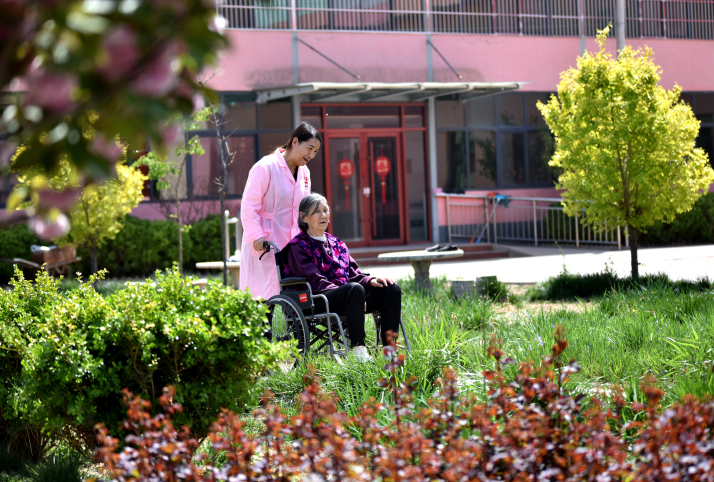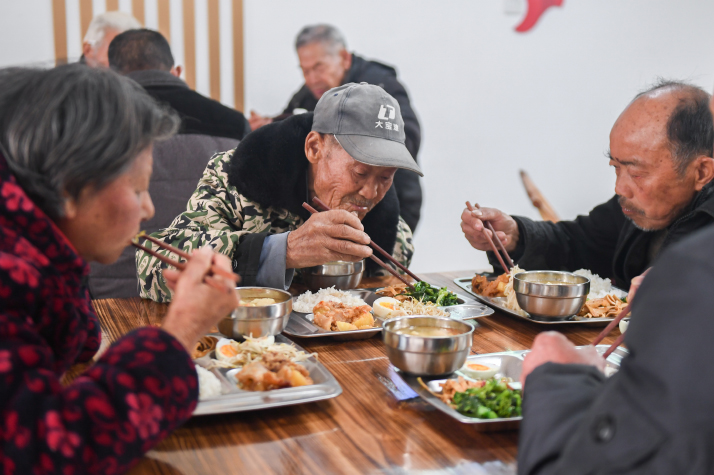
June 25, 2024 -- Every day at noon, about 150 elderly villagers pour into the canteen of a rural community in Yiyuan County, Shandong Province in east China, for a nutritious lunch. The seniors pay a maximum of 2 yuan ($0.27) for each meal, and those over 80 eat for free.
Community-based welfare canteens like this one usually cater to elderly whose children are off working in other regions where they have found better job opportunities. As of this year, over 200 rural community canteens cater to around 85,000 senior villagers in 446 villages in Yiyuan.
China's population has been aging rapidly in recent years. According to the Seventh National Population Census of China conducted in 2020, the population aged 60 and above exceeded 264 million, accounting for 18.7 percent of the country's total population. The proportion of people aged 60 and above in rural areas was 23.81 percent, 7.99 percentage points higher than in urban areas.
"In China, rural areas will need to manage the challenges that come with a rapidly aging population earlier than their urban counterparts. As the country is in a critical phase of demographic transformation, improving rural elderly care is a pressing issue," Yang Ge, an associate researcher with the Institute of Population and Labor Economics at the Chinese Academy of Social Sciences, told Beijing Review.
Rural community canteens and other social services like healthcare have been launched and expanded to meet rural seniors' demands. On June 13, the Chinese authorities released a set of guidelines on improving elderly care services in rural areas. According to the guidelines, state-owned and private enterprises are both encouraged to manage senior care service facilities in rural areas.
The Ministry of Civil Affairs (MCA), one of the authorities, said that the target is to improve the rural elderly care service system, and enhance coverage rate of related centers in townships by 60 percent by 2025.

Supporting seniors
Yang pointed out that the needs of senior citizens differ significantly between rural and urban areas, mainly due to the commonness of left-behind elderly in rural regions resulting from rural-urban migration.
The rural elderly often live alone and work in agriculture. Many of them refuse to relocate to nursing homes, choosing instead to stay in remote areas where access to public services is often still limited.
In recent years, many new senior care services have emerged in rural areas. For instance, in 2008, China's first mutual-aid nursing home was established in Qiantun Village of Handan, Hebei Province in north China. This initiative laid the groundwork for the rural mutual-aid elderly care model found nationwide today.
China's mutual-aid care system, especially in the context of senior care, refers to a community-based scheme where local residents collectively provide support and services for senior citizens.
Undertakings such as the Qiantun nursing home are typically guided by the local government and backed by private investment. Rural community service centers operating under the mutual-aid system provide essential services for the elderly, supported by the active involvement of villagers and volunteers.
In Suqian, east China's Jiangsu Province, 63 mutual-aid elderly care stations have been set up in vacant houses as of this year. These stations cater to local senior citizens by offering daytime care, including recreational activities, and providing meals, all within a stone's throw of their homes.
"Mutual-aid elderly care modes are cost-effective, sustainable and flexible, meeting rural demand," Yang said.
As of this year, China has 16,000 rural elderly care nursing homes with over 1.68 million beds. Additionally, the country has around 145,000 mutual-aid elderly care facilities in rural areas.
However, the MCA has acknowledged that the convenience and accessibility of these facilities need improvement.
Healthcare services for rural seniors are on the rise. In Lanshan District of Rizhao, east China's Shandong Province, elderly care service centers not only offer meals and entertainment, but also provide at-home healthcare services. These centers each receive annual subsidies totaling over 25,000 yuan ($3,445) every year from local government.
To support seniors with disabilities who reside at home, several regions, including Shandong, have initiated plans to launch home-based services. For example, Yiyuan has around 2,600 seniors with disabilities or partial disabilities. The local government has recruited over 700 people to provide home-based services, including meal delivery, assistance with household chores and healthcare support.
Silver opportunities
In January, China's State Council, the highest administrative body, issued a document on promoting the silver economy, which focuses on providing products and services for the elderly. The document proposed new targeted measures across different sectors, including housing, transportation and healthcare.
As the country's silver economy has boomed in recent years, new trends are emerging in elderly care for senior urban residents. Some opt to relocate to rural areas and small cities for their retirement, rather than reside in urban senior care centers.
One example is Zhu Guomin, in his 80s, who in 2022 moved from Shanghai, where he had lived for over seven decades, back to his hometown in Yancheng, Jiangsu in 2022. After battling a severe illness, he decided to move into a local senior care center to alleviate the burden on his family, who had been taking care of him since he got sick. His decision was also influenced by the lower costs—compared to those in Shanghai.
"The senior care centers in cities are more like hotels, available but not livable," Zhu told newspaper The Economic Observer. In Yancheng, he lives in a center far away from the urban hustle and bustle, where he chats with his peers, goes for walks and participates in organized activities.
As of late last year, the number of senior people from Tianjin and Beijing living in elderly care homes in neighboring Hebei had reached almost 5,000, and nearly 40,000 elderly residents from the two cities were residing across the province to enjoy their retirement, according to the Beijing Municipal Bureau of Statistics.
In 2017, Beijing, Tianjin and Hebei implemented measures to facilitate the settlement of cross-regional medical bills. With one medical insurance card, local seniors are able to access medical services and receive reimbursement in any hospital inside the Beijing-Tianjin-Hebei region.
Similarly, Shanghai has introduced policies allowing local seniors residing in nursing homes in neighboring provinces to access its medical insurance system.
To attract more retirees to relocate to smaller cities, Yang suggested these lower-tier areas construct more comprehensive service systems, build senior-friendly communities, and improve healthcare facilities.
Tests and trials
Yang continued that rural areas should further develop senior care homes, mutual-aid centers and public senior canteens. The Chinese authorities should expand healthcare coverage to better support senior rural residents by creating more accessible medical insurance and pension plans, she added.
Despite growing demand, at-home elderly care and community services in rural areas remain insufficient. Persistent issues include inadequate funding, low trust among rural seniors and operational inconsistencies.
Funding shortages stem from a heavy reliance on subsidies from local governments for public services. Private investors are hesitant to invest in elderly care due to the limited consumption capacity of rural residents, Yang explained.
Data from the National Bureau of Statistics showed that in 2023, the per-capita disposable income of urban residents was 51,821 yuan ($7,141), while that of rural residents stood at 21,691 yuan ($2,989). As Yang indicated, there is plenty of room for improving rural residents' incomes before further promoting rural elderly care services.
"In addition to promoting nursing homes, the government should improve at-home care and services for the elderly in communities, especially medical treatment and healthcare, build infrastructure and introduce a database of left-behind elderly people in rural areas to provide better services for them," Yang said.
(Print Edition Title: From Fields to Facilities)
Copyedited by Elsbeth van Paridon


